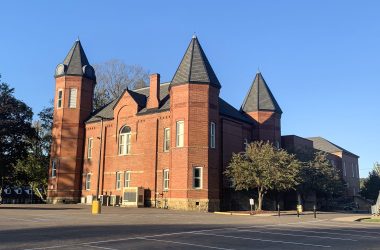The white two-story farm house at 978 Hurricane Creek Road was originally known as the Mit Gibson Place because Mit Gibson built it and resided there until the late 1920’s.
The house is about 400 yards from present day Hurricane city limits. When constructed in 1908, the corporate limits of the Town of Hurricane were more than one mile distant.
Although Mit Gibson did not reside at the home he built during the 1930’s and 1940’s, locals continued to refer to it as the Mit Gibson Place because there were no long-term occupants during that time period. Following World War II, Dave and Irene Ambler moved into the house and it became known as the Dave Ambler place. It continued to be known by that name until after the Amblers passed (Dave – 1993, Irene – 1995). Today, the structure is known as The Breeze because it has served as home to The Hurricane Breeze since 1982.
The original structure consisted of six rooms, three upstairs and three downstairs with a kitchen attached to the rear. Its steep gables and ornate wood scrolling are representative of the Carpenter Gothic architecture of the period in which it was constructed. The front room featured bay windows and a fire place which would have served as the sole source of heat before natural gas became available in the 1930’s. Electric service would wait until the mid to late 1930’s. The house was not fully wired for electric until after the second World War when the Amblers moved in. Indoor plumbing and a 450 square foot addition were added in 1968.
Present day owner, Betsy Allen recently learned that she is Mit’s first cousin, four times removed. Betsy’s mother (Cookie Allen) and grandmother (Irene Forth Ambler) were certain that they were related to Mit because their roots trace directly to Calvary Gibson, patriarch of many, many Gibsons in the Hurricane area. Neither Cookie or Irene knew how Mit was related to Calvary. Neither did they know how or when Mit came to possess the 120 acres which became the Ambler home in 1945. Their knowledge of the property’s history was limited to that which they learned from Robert F. Forth (Irene’s father).
R.F. Forth was born in 1890 on Coon Creek, tributary of Sleepy Creek (tributary of Big Hurricane Creek), approximately one mile north of the Mit Gibson property. R.F. witnessed the construction of Mit’s home through the eyes of an 18-year-old young man. R.F. knew why Mit lost possession of his home. Mit was a pinhooker. He purchased burley tobacco directly from area farmers and resold it at auction when Hurricane’s tobacco warehouses opened. Pinhookers relied upon insider knowledge of the market to make easy money by buying low and selling high. Unfortunately for Mit, his insider information was wrong. He borrowed heavily from Putnam County Bank to buy crops of burley that sold well below their purchased price. Putnam County Bank became the owner of the Mit Gibson place in 1928. The Bank sold the property to John and Lucy Gillispie in 1932. The Great Depression was in full swing and the Gillispies were forced to convey the property back to the Bank in 1935. Cash was in short supply. In 1937, R.F. Forth traded his share of ownership in the cemetery located next to present day U.S. Foods in Hurricane to Putnam County Bank in exchange for Mit’s 120 acres.
Betsy did not know anything concerning Mit until Lisa Estes, an attorney and member of the Vanadalia Historical Society, researched courthouse records. Lisa uncovered Mit’s given name, John Milton Gibson. J.M. Gibson was born in 1871, the son of James Jefferson and Susan Margaret Hodges Gibson. Betsy knew James Jefferson to be a son of Calvary and Lucretia Gibson. Calvary and Lucretia were parents to five sons and one daughter. Betsy is the great-great-great-great-granddaughter of Calvary and Lucretia through their one daughter, Mary Elizabeth.
Lisa found that James Jefferson conveyed 5 tracts of land to Mit in 1898. Mit, at this time, was 27 with a wife (Nancy Catherine Hanley, m. 1890) and several children. Mit’s father was 58 and a widower with an 11-year-old daughter (wife Susan Margaret, d. 1892; dau. Georgia Altia, b. 1887).
The Centennial History of Hurricane, WV family histories reveal that James Jefferson married 31-year-old Laura Bell Sovine in 1899, which marriage produced two daughters. The daughters were aunts were several years younger than a number of their nieces and nephews.
The Centennial History family histories also report that James Jefferson donated acreage for the construction of present day Bethel Baptist Church which was built in 1903.
Little is known of Mit’s children. That said, much is known of the era in which they were born, his 1898 date of ownership, and the 1908 construction time of his home.
The C&O Railroad was completed in 1873 and brought an economic boom with it. Hurricane Bridge transitioned to become Hurricane Station. The Town of Hurricane was incorporated in 1888. Cyrus P. Huntington found it necessary to add a second C&O track in 1905. The railroad’s demand for ties produced cash and wealth for landowners. Hurricane also became the center for shipping tobacco and home to multiple tobacco warehouses.
In the early 1900’s, there were three saloons, all located no further than 50 feet from the railroad tracks. If postings on Ancestry.com are correct, Mit was a frequent visitor to these establishments. The scene changed in 1914 when West Virginia instituted statewide prohibition (six years before nationwide prohibition).
As stated earlier, hard times for Mit preceded hard times of the Great Depression. Mit lost his home when he was 57 years old. He died in Hurricane in 1942 at age 71.




